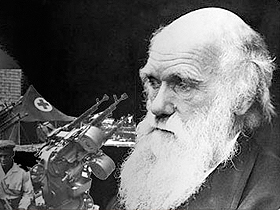Many people imagine the theory of evolution to have been formulated by Charles Darwin and to be based on scientific evidence, observations and experiments. However, the source of the theory is not its intellectual founding father, Darwin, nor any scientific evidence.
At a time when pagan religions dominated Mesopotamia, many beliefs and myths abounded regarding the origin of life and the universe. One of these, surprisingly, was a belief in evolution! According to an inscription from Sumerian times, known as the Enuma-Elish, there was initially watery chaos, out of which two gods, Lahmu and Lahamu, suddenly emerged. According to this myth, these deities first brought themselves into being and then gave rise to other substances and living things. In other words, according to the Sumerian legend, life emerged suddenly out of watery chaos and developed by way of evolution.
 Like modern-day materialists, the ancient Greek materialist philosopher Democritus made the error of thinking that matter was eternal and nothing existed apart from matter. |
The evolution myth later flourished in another pagan civilization—ancient Greece. Athenian philosophers regarded matter as the only absolute entity. They turned to the myth of evolution, inherited from the Sumerians, to explain how life arose. Materialist philosophy and the myth of evolution thus came together in ancient Greece, whence they were transplanted to Roman culture.
The idea that all living things had one common ancestor, maintained by the theory of evolution, was put forward by the French biologist the Comte de Buffon in the mid-18th century. (See Buffon, Comte de.) Charles Darwin’s grandfather, Erasmus Darwin, developed de Buffon’s idea and came up with the first basic propositions representing the concept we today know as the theory of evolution. (See Darwin, Erasmus.)
After Erasmus Darwin, the French natural historian Jean Baptiste Lamarck proposed the first wide-ranging theory of evolution at the beginning of the 19th century. (See Lamarck, Jean Baptiste.) According to him, evolution operated through “acquired characteristics being passed on from generation to generation.” In his view, the changes that living things underwent during the course of their lives were permanent and could be passed on genetically to their offspring.
Lamarck’s theory enjoyed enormous success at the time it was launched. But afterwards, that popularity declined rapidly. People with justified doubts regarding Lamarck’s theories began carrying out their own research.
In 1870, the British biologist Weismann proved that acquired characteristics could not be passed on to subsequent generations and therefore, Lamarck’s theory was wrong. Therefore, the teaching today imposed on us and the entire world as the theory of evolution is not actually based on Lamarck. The birth of Darwinism, known as the theory of evolution the world around, came with the 1859 publication of Charles Darwin’s book The Origin of Species by Means of Natural Selection or the Preservation of Favoured Races in the Struggle for Life.
His theory of evolution denies that living things were created and maintains that they are the product of natural processes and random influences. According to this theory, all living things are descended from one another. A previously existing living species gradually developed turned into another, and eventually, all species emerged in this way. The transition took hundreds of millions of years and was carried forward in stages. Though the theory was been widely accepted for around a century and a half, today it finds itself in conflict with findings from a great many branches of science such as paleontology, biochemistry, anatomy, biophysics and genetics.


